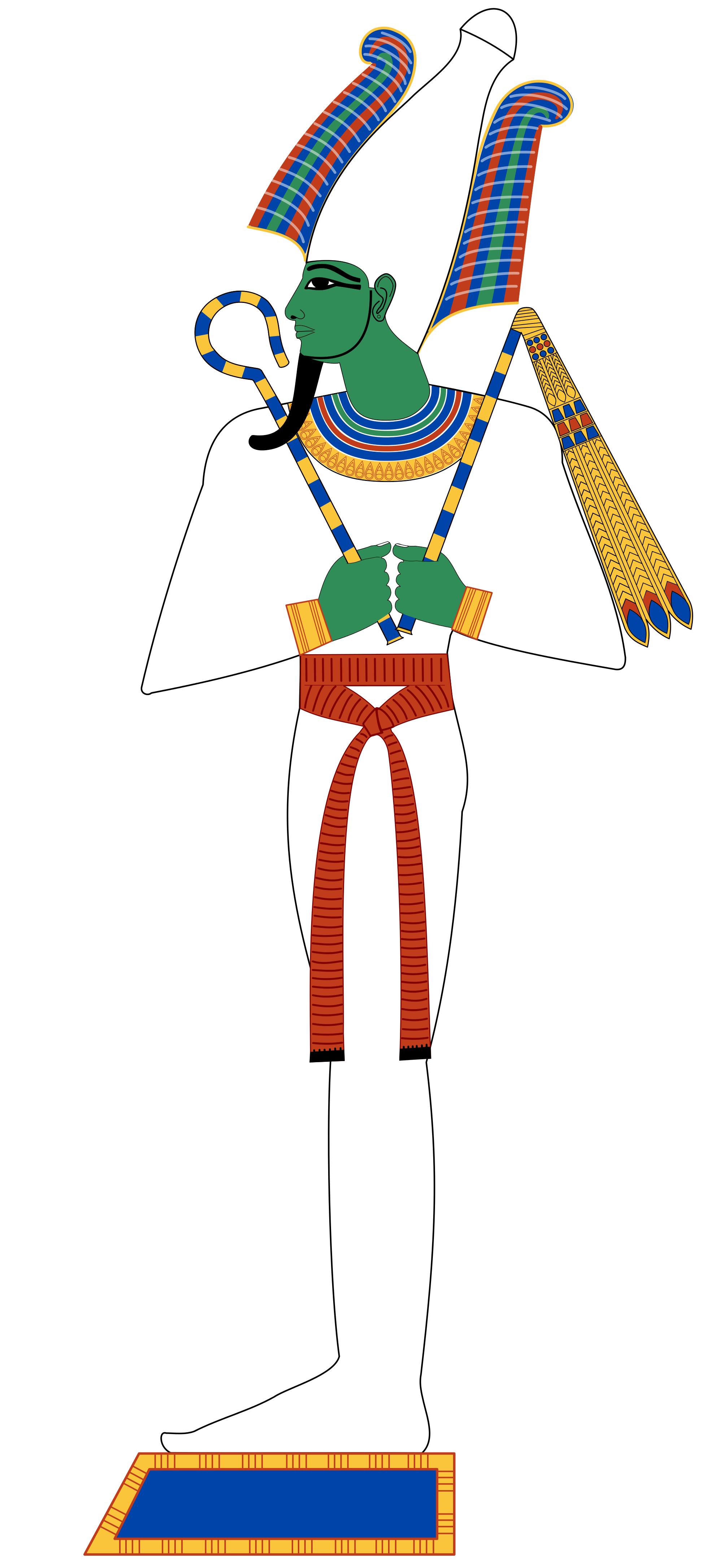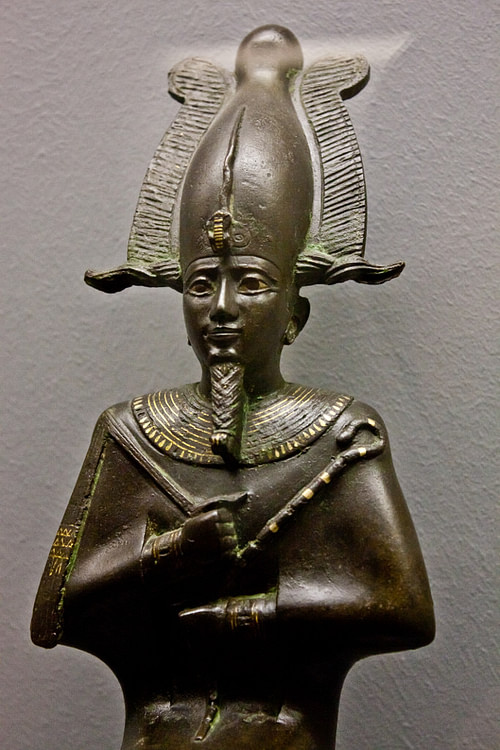

Smith (2017) makes no definitive proposals but asserts that the second element must be a form of jrj ("to do, make") (rather than jrt ("eye")).
 Wolfhart Westendorf (1987) proposes an etymology from wꜣst- jrt "she who bears the eye". David Lorton (1985) takes up this same compound but explains st-jrt as signifying "product, something made", Osiris representing the product of the ritual mummification process. Kurt Sethe (1930) proposes a compound st- jrt, meaning "seat of the eye", in a hypothetical earlier form *wst-jrt this is rejected by Griffiths on phonetic grounds. John Gwyn Griffiths (1980), "bearing in mind Erman's emphasis on the fact that the name must begin with an w", proposes a derivation from wsr with an original meaning of "The Mighty One". Most take wsjr as the accepted transliteration, following Adolf Erman: Several proposals have been made for the etymology and meaning of the original name as Egyptologist Mark J. Since hieroglyphic writing lacks vowels, Egyptologists have vocalized the name in various ways, such as Asar, Ausar, Ausir, Wesir, Usir, or Usire. In Egyptian hieroglyphs the name appears as wsjr, which some Egyptologists instead choose to transliterate as ꜣsjr or jsjrj. Osiris is a Latin transliteration of the Ancient Greek Ὄσιρις IPA:, which in turn is the Greek adaptation of the original name in the Egyptian language. 5.1 Death or transition and institution as god of the afterlife. The accoutrements of the shepherd, the crook and the flail - once insignia of the Delta god Andjety, with whom Osiris was associated - support this theory. Some Egyptologists believe the Osiris mythos may have originated in a former living ruler - possibly a shepherd who lived in Predynastic times (5500–3100 BC) in the Nile Delta, whose beneficial rule led to him being revered as a god. Most information available on the Osiris myth is derived from allusions in the Pyramid Texts at the end of the Fifth Dynasty, later New Kingdom source documents such as the Shabaka Stone and " The Contendings of Horus and Seth", and much later, in the narratives of Greek authors including Plutarch and Diodorus Siculus. The first evidence of the worship of Osiris is from the middle of the Fifth Dynasty of Egypt (25th century BC), although it is likely that he was worshiped much earlier the Khenti-Amentiu epithet dates to at least the First Dynasty, and was also used as a pharaonic title. He became the sovereign that granted all life, "He Who is Permanently Benign and Youthful". Through the hope of new life after death, Osiris began to be associated with the cycles in nature, in particular the sprouting of vegetation and the annual flooding of the Nile River, as well as the heliacal rising of Orion and Sirius at the start of the new year. After the spread of the Osiris cult, however, the kings of Egypt were associated with Osiris in death – as Osiris rose from the dead, they would unite with him and inherit eternal life through imitative magic. In the Old Kingdom (2686 - 2181 BC) the pharaoh was considered a son of the sun god Ra who, after his death, ascended to join Ra in the sky. Osiris was the judge and lord of the dead and the underworld, the "Lord of Silence" and Khenti-Amentiu, meaning "Foremost of the Westerners". Through syncretism with Iah, he was also a god of the Moon. Osiris was at times considered the eldest son of the earth god Geb and the sky goddess Nut, as well as being brother and husband of Isis, and brother of Set, Nephthys, and Horus the Elder, with Horus the Younger being considered his posthumously begotten son. Osiris was widely worshipped until the decline of ancient Egyptian religion during the rise of Christianity in the Roman Empire.
Wolfhart Westendorf (1987) proposes an etymology from wꜣst- jrt "she who bears the eye". David Lorton (1985) takes up this same compound but explains st-jrt as signifying "product, something made", Osiris representing the product of the ritual mummification process. Kurt Sethe (1930) proposes a compound st- jrt, meaning "seat of the eye", in a hypothetical earlier form *wst-jrt this is rejected by Griffiths on phonetic grounds. John Gwyn Griffiths (1980), "bearing in mind Erman's emphasis on the fact that the name must begin with an w", proposes a derivation from wsr with an original meaning of "The Mighty One". Most take wsjr as the accepted transliteration, following Adolf Erman: Several proposals have been made for the etymology and meaning of the original name as Egyptologist Mark J. Since hieroglyphic writing lacks vowels, Egyptologists have vocalized the name in various ways, such as Asar, Ausar, Ausir, Wesir, Usir, or Usire. In Egyptian hieroglyphs the name appears as wsjr, which some Egyptologists instead choose to transliterate as ꜣsjr or jsjrj. Osiris is a Latin transliteration of the Ancient Greek Ὄσιρις IPA:, which in turn is the Greek adaptation of the original name in the Egyptian language. 5.1 Death or transition and institution as god of the afterlife. The accoutrements of the shepherd, the crook and the flail - once insignia of the Delta god Andjety, with whom Osiris was associated - support this theory. Some Egyptologists believe the Osiris mythos may have originated in a former living ruler - possibly a shepherd who lived in Predynastic times (5500–3100 BC) in the Nile Delta, whose beneficial rule led to him being revered as a god. Most information available on the Osiris myth is derived from allusions in the Pyramid Texts at the end of the Fifth Dynasty, later New Kingdom source documents such as the Shabaka Stone and " The Contendings of Horus and Seth", and much later, in the narratives of Greek authors including Plutarch and Diodorus Siculus. The first evidence of the worship of Osiris is from the middle of the Fifth Dynasty of Egypt (25th century BC), although it is likely that he was worshiped much earlier the Khenti-Amentiu epithet dates to at least the First Dynasty, and was also used as a pharaonic title. He became the sovereign that granted all life, "He Who is Permanently Benign and Youthful". Through the hope of new life after death, Osiris began to be associated with the cycles in nature, in particular the sprouting of vegetation and the annual flooding of the Nile River, as well as the heliacal rising of Orion and Sirius at the start of the new year. After the spread of the Osiris cult, however, the kings of Egypt were associated with Osiris in death – as Osiris rose from the dead, they would unite with him and inherit eternal life through imitative magic. In the Old Kingdom (2686 - 2181 BC) the pharaoh was considered a son of the sun god Ra who, after his death, ascended to join Ra in the sky. Osiris was the judge and lord of the dead and the underworld, the "Lord of Silence" and Khenti-Amentiu, meaning "Foremost of the Westerners". Through syncretism with Iah, he was also a god of the Moon. Osiris was at times considered the eldest son of the earth god Geb and the sky goddess Nut, as well as being brother and husband of Isis, and brother of Set, Nephthys, and Horus the Elder, with Horus the Younger being considered his posthumously begotten son. Osiris was widely worshipped until the decline of ancient Egyptian religion during the rise of Christianity in the Roman Empire. 
When his brother, Set, cut him up into pieces after killing him, Isis, his wife, found all the pieces and wrapped his body up, enabling him to return to life. He was one of the first to be associated with the mummy wrap. He was classically depicted as a green-skinned deity with a pharaoh's beard, partially mummy-wrapped at the legs, wearing a distinctive atef crown, and holding a symbolic crook and flail. Osiris ( / oʊ ˈ s aɪ r ɪ s/, from Egyptian wsjr, Coptic: ⲟⲩⲥⲓⲣⲉ, romanized: Ousire Phoenician: 𐤀𐤎𐤓, romanized: ʾsr) is the god of fertility, agriculture, the afterlife, the dead, resurrection, life, and vegetation in ancient Egyptian religion.







 0 kommentar(er)
0 kommentar(er)
